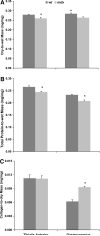Plantarflexion contracture in the mdx mouse
- PMID: 21403594
- PMCID: PMC3392333
- DOI: 10.1097/PHM.0b013e3181fc7c9e
Plantarflexion contracture in the mdx mouse
Abstract
Objective: Contractures are a major clinical issue for patients with muscular dystrophies. However, it is unknown whether contractures are present in the widely used mdx mouse model of Duchenne muscular dystrophy. Therefore, the objectives of this study were to develop methods to measure muscle contractures in mice, to determine whether plantarflexion contractures are present in mdx mice, and to analyze the composition of the major muscles involved.
Design: Hindlimbs of eight wild type and six mdx mice were assessed every 2 wks during the course of a 12-wk study. Assessments included range of motion and in vivo torques about the ankle. At the end of the study, mice were euthanized, and muscles were analyzed for composition.
Results: The mdx mice had ∼10 degrees less dorsiflexion, increased passive torque moving the ankle into dorsiflexion, and an increased passive-to-active torque ratio relative to wild type mice. Gastrocnemius muscle composition alterations included increased wet mass, decreased protein content, and increased collagen.
Conclusions: The results indicate that mdx mice have plantarflexion contractures similar to those seen in children with Duchenne muscular dystrophy. In future studies, these measures can be used to assess strategies to slow the progression of contractures that occur with muscular dystrophies.
Figures




References
-
- Hoffman EP, Brown RH, Kunkel LM. Dystrophin: The protein product of the Duchenne muscular dystrophy locus. Cell. 1987;51:919–28. - PubMed
-
- Sutherland DH, Olshen R, Cooper L, et al. The pathomechanics of gait in Duchenne muscular dystrophy. Dev Med Child Neurol. 1981;23:3–22. - PubMed
-
- McDonald CM. Limb contractures in progressive neuromuscular disease and the role of stretching, orthotics, and surgery. Phys Med Rehabil Clin N Am. 1998;9:187–211. - PubMed
-
- Brooke MH, Fenichel GM, Griggs RC, et al. Clinical investigation in Duchenne dystrophy: 2. Determination of the “power” of therapeutic trials based on the natural history. Muscle Nerve. 1983;6:91–103. - PubMed
-
- Do T. Orthopedic management of the muscular dystrophies. Curr Opin Pediatr. 2002;14:50–3. - PubMed
Publication types
MeSH terms
Substances
Grants and funding
LinkOut - more resources
Full Text Sources

